Oppositional sexism is the belief that male and female, or masculine and feminine, are two separate and rigid opposing categories, each with their own attributes and characteristics. According to people who ascribe to oppositional sexism, the abilities, traits, and other attributes which are seen as masculine cannot and should not be feminine, and vice-versa.
Julia Serano coined the term oppositional sexism in her first book “Whipping Girl: A Transsexual Woman on Sexism and the Scapegoating of Femininity.” Her new term looked to become an umbrella term for other recognized types of sexism, including cissexism and transphobia.
More About Oppositional Sexism
The beliefs held under oppositional sexism follow traditional gender stereotypes. Maleness is associated with athleticism, strength, and power. Femaleness is associated with fragility, domesticity, and nurturing. Women with traits traditionally associated with maleness and men with traits traditionally associated with femaleness are ostracized and even punished under oppositional sexism.
Oppositional sexism has come under fire by many academics, especially queer theorists and transgender activists. For them, the binary gender dynamic established and perpetuated by oppositional sexism ignores the full spectrum of gender identities found in society. Others rail against the way that even cisgender individuals often don’t fit neatly in a gender box. Instead they will often have a mix of attributes traditionally regarded as masculine and feminine. In fact, these attributes are not really masculine or feminine, as oppositional sexism suggests, but rather human attributes present in all of us, regardless of gender identity, to varying degrees.
Oppositional sexism, along with traditional sexism, contributes to an overarching attitude of sexism within society. All individuals must challenge oppositional sexism for true gender equality.



